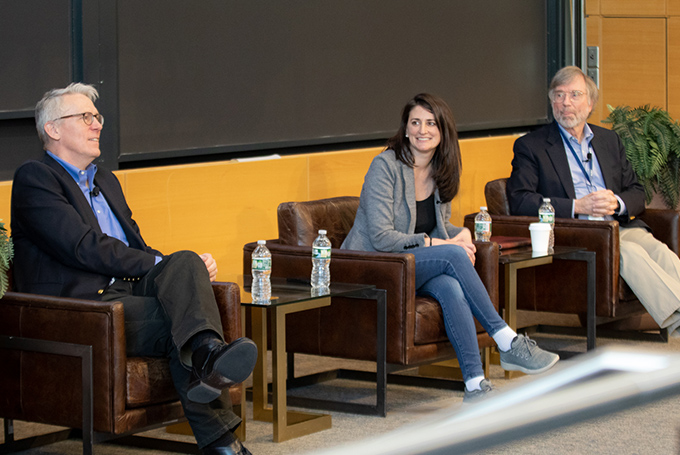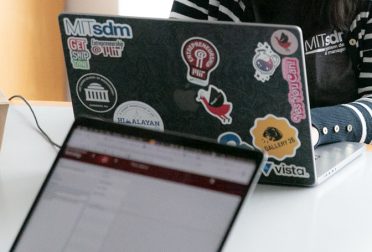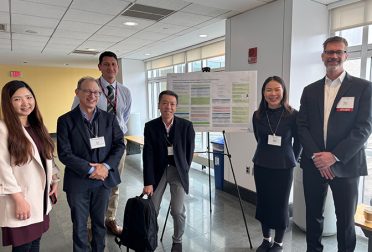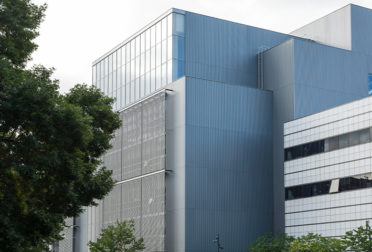by Kathryn O’Neill
MIT System Design and Management (SDM) celebrated its 25th anniversary on Saturday, April 2, with a daylong conference in Wong Auditorium at MIT. The celebration was attended in person and online by about 200 alumni, students, faculty, and friends of the program.
Throughout the day, speakers reflected on the vision of the program—which pioneered bringing engineering and management education together in a combined graduate degree—and on how graduates have benefited from their training in systems thinking, SDM’s bedrock philosophy of tackling complex problems holistically.
“It was amazing to see everyone come back and share their stories and see the impact SDM has had,” said SDM Executive Director Joan Rubin.
“I can’t overstate the impact that SDM has had on my life,” said Maj. Arthur Middlebrooks SDM ‘17, an assistant professor of systems engineering at the US Military Academy. “I remain deeply grateful.”
Rubin began the day by welcoming guests and sharing a short promotional video from the program’s first year in which then-MIT President Charles Vest said, “We think SDM is very much a cutting-edge program.” Twenty-five years later, Rubin remarked, SDM is “different, but it hasn’t changed all that much.”
Rubin then introduced the architects of SDM’s vision—cofounders Edward Crawley, Ford Professor of Engineering, and Institute Professor Thomas Magnanti—who shared their memories of the program’s founding.
The pair began the task, Crawley said, by asking industry leaders what skills and capabilities they needed in their workforce. “The way academic programs are usually designed is, academics sit around and decide what students need to learn. We went to stakeholders and asked, what should a leader of engineering know how to do?” Crawley said.
Recognizing that midcareer professionals would have difficulty leaving work for full-time graduate school, the pair also determined it would be critical to offer online credentials. SDM became MIT’s first degree-granting distance education program.
“We created this vision of a distance campus”—with online classes, projects, documents, and office hours—a vision that captivated and won approval from the MIT faculty. Even so, in the early years, Crawley admitted, “We delivered almost none of that. It took technology time to catch up.”
From the start, however, SDM offered a foundation in system design, system architecture, and project management—elements that remain core components of the program today. Early graduate Lisa Cratty SDM ’01, who now serves as senior vice president and head of product engineering at Siemens Healthineers Lab Diagnostics, called her experience in the program “life-changing.” She said systems thinking helped her pivot her career several times, from the automotive industry to childcare products to medical devices. “You can take the systems approach to many things,” she says. “It shows the enduring nature of the program. It’s a thought process.”
Speakers emphasized that the program’s continuing focus on systems thinking does not mean that SDM has remained stagnant. As Crawley noted, the program has made use of “continuous process improvement” to adjust coursework and class offerings for the better over the years.
For example, Olivier de Weck, Apollo Program Professor and Professor of Astronautics and Engineering Systems, told the audience about launching a new course a few years ago focused on technology roadmapping. While de Weck has been associated with SDM since 2001, he took a leave from MIT in 2017 to work at Airbus and brought the insights he gained from industry back to MIT. He described technology roadmapping as a quantitative process focused on four questions: Where are we today? Where could we go? Where should we go? and finally, Where are we going?
Following de Weck’s talk, Stephen Boyer SDM ’07, founder and chief technology officer of BitSight, offered his perspective on how systems thinking supports entrepreneurship. “It’s been more of a mindset that a proscribed practice,” he said, advising would-be founders to stay focused on the needs of the customer and to aim for continuous improvement of both products and processes. “You’re never done iterating,” he said.
After a lunch break, the afternoon session began on a somber note with a slide show tribute to former SDM Executive Director Pat Hale SM ’84, who died in February. Rubin called Hale “an inspiration” with an “unwavering commitment to students.”
The rest of the afternoon was devoted to SDM’s present and future, beginning with a panel discussion on the recently redesigned core curriculum. Bryan Moser, SDM academic director and senior lecturer, led this discussion with panelists Bruce Cameron, director of the System Architecture Group; de Weck; PhD candidate George Lordos, who has served as lead teaching assistant in the SDM core; Eric Rebentisch, research associate in the Sociotechnical Systems Research Center; and Donna Rhodes, director of the Systems Engineering Advancement Research Initiative.
Moser outlined SDM’s core curriculum, which consists of three integrated classes— system architecture, systems engineering, and project management—spread over nine months. He noted that SDM students take classes across the Institute, including in the Sloan School of Management and in every department in the School of Engineering, and he heralded statistics that show they take more classes and get better grades than most other MIT graduate students. “SDM students are special in this special place,” he said.
He then asked the panelists to reflect on SDM’s changes, and all said that working together to create an integrated core has improved the program. “We have this relentless drive for continuous improvement,” Rebentisch said. Moser noted that SDM seeks regular feedback from students and meets every year to determine what worked well and what could be better, tweaking the program as needed.
Following the panel discussion, Ben Linville-Engler SDM ’16 shared his experience putting systems thinking to work during the pandemic. Linville-Engler, the director of the Massachusetts eHealth Institute and chief investment strategist for the Massachusetts Technology Collaborative, was serving as SDM’s industry and certificate director when Covid emerged. He led an effort to help local manufacturers fulfill the need for personal protective equipment (PPE)—work for which he was awarded MIT’s Collier Medal in 2021. “Ultimately, we helped over 50 companies pivot to make PPE,” he said.
In the final session of the day, SDM’s faculty co-director Steven Eppinger, General Motors LGO Professor of Management, led a panel discussion on the future of engineering management. The panelists were: Andrea Ippolito SDM ’11, founder and CEO of SimpliFed; Middlebrooks; Geoffrey Parker SM ‘93, PhD ‘98, professor of engineering at Dartmouth and visiting scholar at MIT; and SDM faculty co-director Warren Seering, the Weber-Shaughness Professor of Mechanical Engineering.
Noting that “SDM was created explicitly to create the tech leaders of future,” Eppinger asked each panelist what will be most important in the years ahead. Their answers ran the gamut.
“When I think of the future of systems thinking, I think there needs to be more focus on social infrastructure,” Ippolito said.
“I think a lot about digital transformation,” said Parker.
Middlebrooks said he thinks it will be important to incorporate a broad spectrum of feedback into improving systems, “including all demographics, whether that’s race, gender, or socioeconomic status.”
Seering said sustainability needs to be built into future systems as well continuous learning—because change is a constant. “We can’t see the future, but we know change will be built into it,” he said.
Ippolito agreed. “If you don’t have a learning mindset, you will be left behind,” she said. “Organizations that create a learning environment are the ones that will succeed.”
She might well have been talking about SDM. Even after 25 years, Seering noted, “we’re not done learning yet.”
Following the daylong conference, SDM concluded its anniversary celebrations with a gala dinner Saturday at Boston’s Museum of Science. The weekend also featured an alumni-student social at Glass House in Kendall Square on Friday evening.
Video recordings of the day’s proceedings are available on the SDM YouTube channel.




